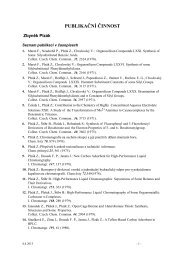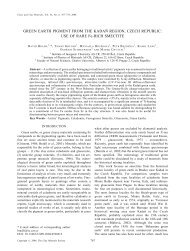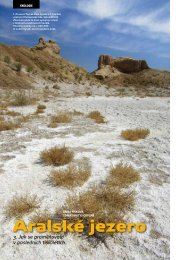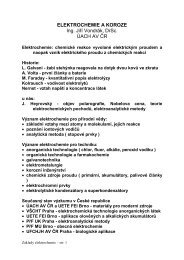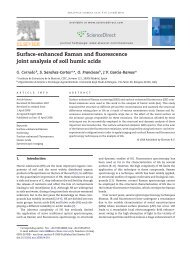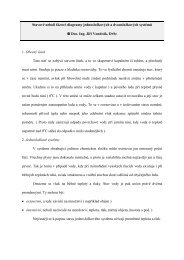Microanalytical identification of Pb-Sb-Sn yellow pigment in ...
Microanalytical identification of Pb-Sb-Sn yellow pigment in ...
Microanalytical identification of Pb-Sb-Sn yellow pigment in ...
Create successful ePaper yourself
Turn your PDF publications into a flip-book with our unique Google optimized e-Paper software.
D. Hradil et al. / Journal <strong>of</strong> Cultural Heritage 8 (2007) 377e386<br />
383<br />
Table 4<br />
List <strong>of</strong> X-ray powder microdiffraction results: dist<strong>in</strong>guish<strong>in</strong>g <strong>of</strong> type I and II <strong>of</strong> lead t<strong>in</strong> <strong>yellow</strong> and <strong>Pb</strong>-<strong>Sb</strong>-<strong>Sn</strong> <strong>yellow</strong> and Naples <strong>yellow</strong>, respectively, <strong>in</strong> real<br />
samples <strong>of</strong> pa<strong>in</strong>t<strong>in</strong>gs (ordered by their age)<br />
Code Name and description Pa<strong>in</strong>t<strong>in</strong>g technique Dat<strong>in</strong>g Analytical methods Type <strong>of</strong> <strong>Pb</strong>-based<br />
<strong>yellow</strong><br />
M0605 Master from Vyšší Brod: Lady Day,<br />
Tempera on wood 1st half <strong>of</strong> 15th SEM/EDS, micro-pXRD <strong>Pb</strong>-<strong>Sn</strong> Type I<br />
National Gallery e Prague<br />
century<br />
M0608 Unknown pa<strong>in</strong>ter: Assumpta from<br />
Tempera on canvas 15th century SEM/EDS, micro-pXRD <strong>Pb</strong>-<strong>Sn</strong> Type I<br />
White Mounta<strong>in</strong>; National Gallery e Prague<br />
M0405 Funeral crown <strong>of</strong> the Czech k<strong>in</strong>g Charles IV., Tempera on wood 1471 SEM/EDS, micro-pXRD <strong>Pb</strong>-<strong>Sn</strong> Type I<br />
Prague Castle<br />
M0429 Lucas Cranach, Franciscan Monastery at Kadaň Tempera wall pa<strong>in</strong>t<strong>in</strong>g 1472e1553 SEM/EDS, micro-pXRD <strong>Pb</strong>-<strong>Sn</strong> Type I<br />
M0524<br />
M0356 Michiel Coxie: Altar piece; National Gallery - Prague Oil tempera on wood 1498e1590 SEM/EDS, micro-pXRD <strong>Pb</strong>-<strong>Sn</strong> Type I<br />
J0517 Unknown author: Virg<strong>in</strong> Mary with Child Polychromy on wood Late Gothic SEM/EDS, micro-pXRD <strong>Pb</strong>-<strong>Sn</strong> Type I<br />
J0534 Unknown pa<strong>in</strong>ter: Miracle <strong>in</strong> Church (Lithuania) Oil on canvas 1677 (?) SEM/EDS, micro-pXRD <strong>Pb</strong>-<strong>Sn</strong> Type I<br />
M0366 Unknown pa<strong>in</strong>ter: Decapitation <strong>of</strong> St. Cathar<strong>in</strong>a, Oil on canvas 18th century SEM/EDS, micro-pXRD <strong>Pb</strong>-<strong>Sn</strong> Type I<br />
Museum <strong>of</strong> Walachia <strong>in</strong> the Open Air <strong>in</strong><br />
Roznov pod Radhoštěm<br />
J0513 Unknown pa<strong>in</strong>ter: Celebration; Velké Los<strong>in</strong>y Castle Oil on canvas 18th century (?) SEM/EDS, micro-pXRD <strong>Pb</strong>-<strong>Sn</strong> Type I<br />
M0526 Unknown pa<strong>in</strong>ter: Calvary e III., V. and VII.<br />
M0601 Interception; Franciscan Monastery <strong>in</strong> Kadaň<br />
M0602<br />
M0420 Franz Cauzig: Themistokles is Look<strong>in</strong>g for<br />
Recourse chez Admét K<strong>in</strong>g; Velké Los<strong>in</strong>y Castle<br />
M0421 Franz Cauzig: Hyrnéthó is Die<strong>in</strong>g <strong>in</strong><br />
Déiphoto’s arms; Velké Los<strong>in</strong>y Castle<br />
J0527 J.B. Lampi young: Portrait <strong>of</strong> Young Women with<br />
Flowers; Moravian Gallery e Brno<br />
J0516 Friedrich Amerl<strong>in</strong>g: Portrait <strong>of</strong> Young girl <strong>in</strong><br />
Oriental Turban; Moravian Gallery e Brno<br />
Oil on canvas After 1770 SEM/EDS, micro-pXRD <strong>Pb</strong>-<strong>Sb</strong> (Naples),<br />
<strong>Pb</strong>-<strong>Sb</strong>-<strong>Sn</strong><br />
Oil on canvas 1755e1828 SEM/EDS, micro-pXRD <strong>Pb</strong>-<strong>Sb</strong> (Naples)<br />
Oil on canvas 1755e1828 SEM/EDS, micro-pXRD <strong>Pb</strong>-<strong>Sb</strong> (Naples)<br />
Oil on canvas 1775e1837 XRF, SEM/EDS, micro-pXRD <strong>Pb</strong>-<strong>Sb</strong>-<strong>Sn</strong><br />
Oil on canvas 1825e1830 XRF, SEM/EDS, micro-pXRD <strong>Pb</strong>-<strong>Sb</strong>-<strong>Sn</strong><br />
The artworks are placed <strong>in</strong> Czech Republic unless other country is given at the description. Abbreviations: micro-pXRD X-ray powder microdiffraction, XRF<br />
non-<strong>in</strong>vasive X-ray fluorescence spectrometry, SEM/EDS electron microscopy with EDS analyser.<br />
advantageously K 2 CO 3 (added traditionally as calc<strong>in</strong>ed potassium<br />
hydrogen tartrate), the calc<strong>in</strong>ation temperature should be<br />
rather higher (best 850e900 C with NaCl flux), and its colour<br />
is warm <strong>yellow</strong>, i.e. with reddish hue (Table 2, Fig. 2). The hue<br />
<strong>of</strong> Naples <strong>yellow</strong>s could be tuned to some extent by the actual<br />
<strong>Pb</strong>:<strong>Sb</strong> ratio (Fig. 2). The <strong>Pb</strong>-<strong>Sb</strong>-<strong>Sn</strong> <strong>yellow</strong> is formed under<br />
similar conditions as Naples <strong>yellow</strong>, i.e. <strong>in</strong> NaCl flux between<br />
750e900 C, and its colour closely resembles lead t<strong>in</strong><br />
<strong>yellow</strong> type II, i.e. it lacks the orange hue <strong>of</strong> Naples <strong>yellow</strong>.<br />
If <strong>Sb</strong> 2 S 3 was used <strong>in</strong>stead <strong>of</strong> <strong>Sb</strong> 2 O 3 , the salt flux was not necessary,<br />
and excess <strong>of</strong> <strong>Pb</strong> should compensate the formation <strong>of</strong><br />
<strong>Pb</strong> sulphates by-products. Naples and <strong>Pb</strong>-<strong>Sb</strong>-<strong>Sn</strong> <strong>yellow</strong>s hence<br />
required a good knowledge on their technology. The hue <strong>of</strong><br />
Naples <strong>yellow</strong> is very similar to hue <strong>of</strong> some ferric ochres<br />
and there is a question why this <strong>pigment</strong> was produced. Maybe<br />
its usage <strong>in</strong> pa<strong>in</strong>t<strong>in</strong>g was only a secondary purpose beside<br />
glass and glaze mak<strong>in</strong>g. On the other hand, the clear <strong>yellow</strong><br />
colour <strong>of</strong> <strong>Pb</strong>-<strong>Sb</strong>-<strong>Sn</strong> <strong>yellow</strong> made it unique with respect to<br />
<strong>yellow</strong> ochres.<br />
One more reason to produce different <strong>Pb</strong>-based <strong>yellow</strong>s<br />
dur<strong>in</strong>g the history <strong>of</strong> f<strong>in</strong>e arts was an actual access to raw materials.<br />
The access to important stibnite (<strong>Sb</strong> 2 S 3 ) deposits and<br />
<strong>Sb</strong> metallurgy <strong>in</strong> Caucasia probably allowed us<strong>in</strong>g <strong>Pb</strong> 2 <strong>Sb</strong> 2 O 7<br />
as <strong>pigment</strong> <strong>in</strong> Egyptian glass <strong>of</strong> the second millennium BC<br />
[10]. Further large deposits <strong>of</strong> stibnite are <strong>in</strong> Turkey, and<br />
maybe this caused that the European knowledge <strong>of</strong> Naples <strong>yellow</strong><br />
is searched for <strong>in</strong> the Near East production <strong>in</strong> the<br />
beg<strong>in</strong>n<strong>in</strong>g <strong>of</strong> the second millennium AD [5]. Actually the<br />
low availability <strong>of</strong> <strong>Sb</strong> reportedly caused usage <strong>of</strong> Fe oxides<br />
as a substitute <strong>of</strong> Naples <strong>yellow</strong> <strong>in</strong> decoration on ceramics produced<br />
<strong>in</strong> Sicily dur<strong>in</strong>g Renaissance [16]. Similarly, huge cassiterite<br />
(<strong>Sn</strong>O 2 ) deposits <strong>in</strong> the north-east Bohemia used s<strong>in</strong>ce<br />
the early Middle Ages might favour us<strong>in</strong>g lead t<strong>in</strong> <strong>yellow</strong>s<br />
and also <strong>Pb</strong>-<strong>Sb</strong>-<strong>Sn</strong> <strong>yellow</strong>s <strong>in</strong> Mid-European art. The access<br />
to raw materials probably also affected the choice <strong>of</strong> flux<br />
agents: v<strong>in</strong>e lees and its calc<strong>in</strong>e were surely easier available<br />
<strong>in</strong> Mediterranean countries with huge v<strong>in</strong>e production than<br />
<strong>in</strong> northland.<br />
4.3. Analysis <strong>of</strong> artworks<br />
For a rout<strong>in</strong>e estimation <strong>of</strong> <strong>pigment</strong>s <strong>in</strong> colour layers <strong>of</strong> artworks,<br />
elemental composition measured by SEM/EDS or<br />
X-ray fluorescence analysis are commonly used. Accord<strong>in</strong>g<br />
to results <strong>of</strong> elemental analyses <strong>of</strong> 44 artworks we concluded<br />
that none <strong>of</strong> the <strong>yellow</strong>s <strong>in</strong> the pa<strong>in</strong>t<strong>in</strong>gs dated to the period<br />
from 15th to 17th century conta<strong>in</strong>ed antimony; only lead t<strong>in</strong><br />
<strong>yellow</strong> was used <strong>in</strong> a typical association with white lead (basic<br />
lead carbonate) <strong>in</strong> <strong>yellow</strong>s and verdigris (copper acetates) or<br />
malachite (basic copper carbonate) <strong>in</strong> light greens. Type I is<br />
exclusively present as confirmed by X ray microdiffraction<br />
<strong>in</strong> 9 cases (Table 4).<br />
Yellow ochres alternated lead t<strong>in</strong> <strong>yellow</strong> <strong>in</strong> warmer <strong>yellow</strong><br />
colours but these two <strong>pigment</strong>s were only rarely mixed together.



